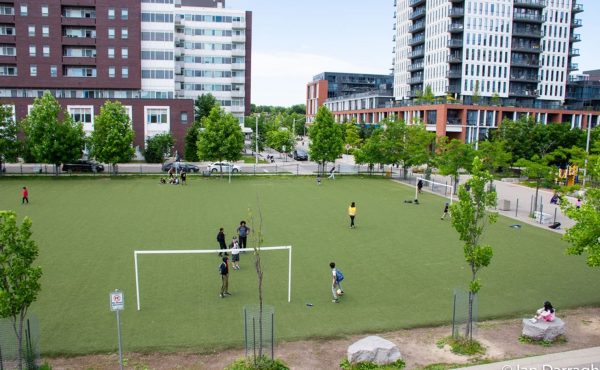
The street-length rush line awaiting my arrival outside the Royal testified to the amount of buzz Hubert Davis’ “Invisible City†has been getting (making it quite possibly the hottest Doc in the festival after Baichwal’s “Act of God”). A title-riff on Ralph Ellison’s portrait of alienation, “Invisible Man,†Davis’ piece follows two high-school kids— Kendell and Mikey — as they grow up in Toronto’s Regent Park. This housing project, the oldest of its kind in Canada, is in the process of a huge redevelopment that holds a very uncertain future for the community. These parallels — between the unrelenting evolution of urban form and community — are powerfully explored throughout the film.
“Invisible City†reminds me a lot of “Killer of Sheep,†Charles Burnett’s masterpiece portrait of Watts, Los Angeles, in the 1970s. Both explore black communities in urban centres with a special ability to capture their vividness — a sun-dappled tree-shadow across a cracked courtyard — within a city that has half-forgotten they exist. The cinematography throughout “Invisible Cities†is beautiful; Davis is especially deft at capturing the expressiveness of his subjects — the avoiding glances, dismissive smirks and wide grins — as they deal with quiet frustrations and unexpected challenges. Mikey is shy and cerebral; he wants to take an advanced math class but also deals crack and skips curfew. Kendell is handsome and athletic; a natural with little kids who gets in trouble for fighting and skipping basketball practice. Both are supported by single mothers who seem always exhausted and yet are completely dedicated. “I love him bad,†Mikey’s mom says. These interactions seem to become more and more compelling as the story grows.
Fortunately there is also Ainsworth, a former pro-athlete who has returned to the neighborhood as a school teacher. Ainsworth understands his role as surrogate father to these kids — one extends far beyond the class room. He lectures them in the parking lot, invites them over for family dinner, jokes with them in the hallway. Three years of high-school life unfold against the rhythm of Regent’s wrecking ball deconstruction — a backdrop which mimics the helplessness of change that each boy is confronted with. Mikey dreams of getting out of Regent, of seeing of the world, but the pull of neighbourhood is strong. “It’s all right here,†he says, pointing toward the playground where he grew up. “All my memories are right here.â€
And then? And then the movie ends. The lights go up and there they are, in the audience with family and friends. Kendell, Mikey, everyone is invited to the stage for an audience Q & A. Mikey and Kendall are still in high-school, it turns out, finishing off some final credits. Their mothers are still working overtime to support them. Mikey’s mom is still worried about Mikey’s attitude. And when Kendall’s mom gets the microphone, she makes a powerful appeal for absentee fathers to man up, just like she did in the movie.
Some people in the audience were chuckling as this was going on; others were not. It was hard to know how to react, because if one thing was certain, it’s that this story isn’t finished. This chapter isn’t even finished. Not that it is has to be: “Invisible City†is an exceedingly honest work, and it would appear false to just assume a portrait of community with so much looming just overhead could just be tied into a little box. But why end the story now? What about the mothers — so self-effacing they aren’t even given names in the film— what is going to happen to them? We sat watching Kendall and Mikey field questions on-stage about their “future†— their half-grins no doubt betraying some embarrassment at the bizarreness of the whole exercise. It was a strange coda to the performance of the documentary form; taking as it did, the visible scaffold of “Invisible City†right off before our eyes.


2 comments
Why is it that Toronto’s housing projects always get the attention? The kids in Regent Park have got a city and a neighbourhood full of great resources, community activities and opportunity that kids in smaller and mid-sized communities will never get. The filmmakers should be going to Brantford or St. Catherines to see the real social problems and the real helplessness. Those are the REAL invisible cities…meanwhile, this “look” at Regent Park is a painfully tired idea.
The fact that it has become the favourite of the festival however is unsurprising. After all, people in Toronto are hopelessly self-indulging about their so-called mosaic. Apparently the critics at Spacing are guilty of this as well…
Point taken, James, but really this film is getting attention because it is one of the few that treats contemporary life in this city, not because it’s about the only kind of “invisible city” Toronto (or Spacing) cares about.
Making documentaries about Canadian topics is so challenging at so many levels that it wouldn’t be very helpful of us to whine about the topics that do finally make it to screen. When someone musters the money, time, and contacts to make a film about the “real” social problems you mention in Brantford and St. Catherines, I’m sure Hot Docs audiences and Spacing reviewers will flock to it too.